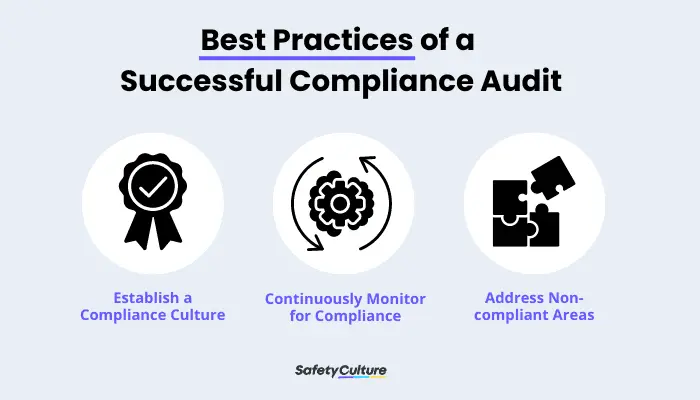What is a Compliance Audit?
A compliance audit is a systematic and independent examination of an organization’s operations, processes, and procedures to determine whether they align with applicable laws, regulations, internal policies, and industry standards. This process helps identify areas of non-compliance, enabling corrective actions to be taken promptly.
Importance
Compliance audits are essential for businesses to demonstrate their commitment to legal and ethical conduct. Here are the key reasons why you should carry out these audits in your processes:
- Regulatory Adherence: Compliance audits help ensure companies stick to the relevant laws, regulations, and industry standards.
- Regulatory Changes: As regulations evolve, compliance audits help organizations adapt and stay up to date with the new requirements and remain updated with the changing legal landscape.
- Risk Mitigation: By identifying and addressing potential non-compliance issues, compliance audits help mitigate compliance risks, protecting the organization from financial and reputational damage.
- Trust and Reputation: Demonstrating a commitment to compliance through regular audits builds trust with stakeholders, including customers, investors, and business partners.
- Operational Efficiency: Compliance audits often lead to the improvement of internal processes and controls, enhancing operational efficiency and reducing wasteful practices.
- Transparency and Accountability: Conducting audits and adhering to compliance standards demonstrate transparency to stakeholders, enhancing accountability at all levels of the organization.
- Prevention of Fraud and Misconduct: Audits can uncover fraudulent activities and misconduct, helping organizations take corrective actions and prevent such occurrences in the future.
These practices help ensure that stakeholders are confident in the organization’s operations and help maintain a positive corporate image.
Compliance Audit Types
Compliance audits and criteria vary depending on the industry of your organization. Some audits are voluntary and some are compulsory. The criteria may also vary depending on the nature of your business. The following are just a few examples :
- Occupational Health and Safety Act (OSHA): OSHA compliance audits assess whether organizations prioritize employee safety and adhere to health and safety regulations. OSHA also grants workers the right to report unsafe conditions without fear of retaliation and participate in safety initiatives.
- International Organization for Standardization (ISO): ISO standards provide best practices and guidelines that help businesses and organizations improve quality, efficiency, and safety while ensuring consistency and compatibility of their products/services on a global scale. Achieving ISO certification showcases an organization’s commitment to excellence and continuous improvement.
- Health Insurance Portability and Accountability Act (HIPAA): HIPAA protects the privacy and security of individuals’ health information. HIPAA establishes standards and safeguards for the electronic transmission, storage, and handling of individual health data.
- General Data Protection Regulation (GDPR): GDPR aims to ensure that personal data is processed lawfully, transparently, and for specific purposes while safeguarding individuals’ rights. It places the responsibility on organizations to handle personal data responsibly and protect it from unauthorized access or disclosure.
Most of these compliance standards may be required by your local regulations. However, some may be optional, such as the ISO certification (although they may potentially benefit your organization).
Preparing For This Audit
Proper preparation is essential to ensure a smooth and successful audit process. By following these steps, your organization can be well-prepared for a compliance audit:
Step 1: Build an Effective Compliance Team
Assemble a dedicated audit team comprising individuals with expertise in compliance, legal, and relevant business functions. Designate a team leader to coordinate audit preparations.
Step 2: Assess Regulatory Requirements
Educate your team with relevant laws, regulations, and industry standards that apply to your organization. Visit and acquire the necessary guidelines to help you and your team be informed about your objectives.
Step 3: Review Internal Policies and Procedures
Thoroughly review your organization’s internal policies and procedures and see if they align with the applicable compliance regulations. Identify any gaps or areas that may need improvements.
How to Conduct a Compliance Audit
This systematic review involves assessing the various aspects of your business operations, such as documentation, on-site observations, and personnel interviews, to identify potential non-compliance issues.
Step 1: Define the Compliance Audit Scope
Clearly define the scope of the compliance audit, including the areas and regulations to be evaluated. Establish specific audit objectives to guide the assessment by creating a brief compliance audit checklist. Pinpoint areas where compliance breaches are more likely to occur and prioritize them for further examination.
Step 2: On-site Assessment
An on-site assessment should involve physically visiting the organization’s facilities to observe processes, assess controls, and interview personnel. This step provides valuable insights into the day-to-day operations and compliance practices.
Step 3: Collect Relevant Data and Documentation
Collect relevant documents, policies, procedures, licenses, permits, and records that demonstrate the organization’s compliance efforts. Organize these documents for easy reference during the audit. Analyze the gathered data and documentation to determine if they align with the applicable regulations and internal policies.
Create your own Compliance Audit checklist!
Streamline your process and digitize your workflow.
Get Started for Free

Best Practices
Regular compliance audits and continuous monitoring help maintain adherence to regulations and industry standards and identify potential non-compliance issues proactively. Here are the best practices for a successful compliance audit in your organization:
Establish a Compliance Culture
Create an environment where all employees understand the importance of compliance and actively participate in upholding ethical practices. It also helps to utilize and integrate convenient compliance software into the company’s day-to-day operations. This way, organizations can build a culture that promotes transparency, accountability, and a commitment to following applicable laws and regulations.
Continuously Monitor for Compliance
To get the best results, the audit process shouldn’t stop at implementing changes for compliance. Businesses should also closely monitor operations after the audit to observe compliance among employees.
By assessing and addressing any potential noncompliant areas and practices found during the monitoring stage, organizations can ensure timely corrective actions and stay ahead of regulatory changes. This proactive approach not only reduces the risk of violations and penalties but also promotes transparency and trust among stakeholders.
Address Noncompliant Areas
During the audit, compliance issues may be uncovered, which can range from minor deviations to more significant violations of regulations. Identifying the root causes of noncompliance is important for implementing effective corrective action plans and preventing future occurrences.
Frequently Asked Questions (FAQs)
The frequency of compliance audits varies based on industry standards and the organization’s specific needs. Some conduct audits annually, while others may do so quarterly or as required by regulations.
While compliance audits can significantly reduce the risk of legal disputes by identifying and addressing compliance issues, they cannot guarantee complete immunity from legal challenges.
The duration of a compliance audit depends on the size of your organization, its complexity, and the scope of the audit. It can take anywhere from a few days to several weeks.
Yes, third-party vendor compliance audits can be a valuable tool for companies seeking an impartial evaluation of their regulatory adherence. By partnering with a reputable vendor, companies can leverage external expertise and gain valuable insights to enhance their compliance efforts.




